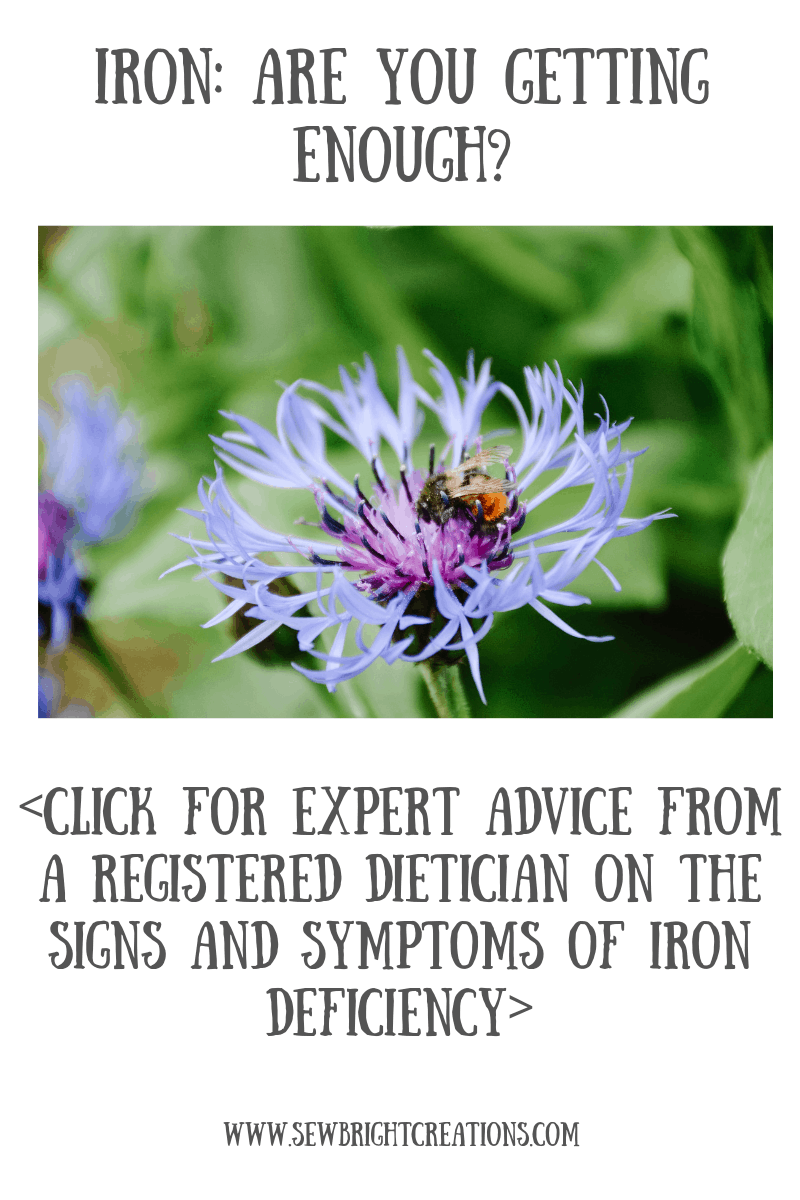Feeling super tired? More tired than normal? No idea why? Have you thought about getting your iron checked?
Last fall I was so tired. I couldn’t figure out why. I’m a morning person and always the most productive in the morning, but by noon I felt like my day was over and I needed to nap. Even if I did nap I would still be tired. I woke up tired, no matter how I slept and I just couldn’t figure out why. I had lots of people tell me it was normal, being tired is a part of mom life or to just take advantage of the times you do feel good. Something just seemed off though. I was more anxious than normal and just felt like I wasn’t myself.
I was at a friend’s house one day and I mentioned how tired I had been. She asked if I’ve had my iron checked. My gosh, how could I have not thought about this? As soon as I got home I booked a doctor’s appointment and asked to get my iron checked. Sure enough, it was low. It wasn’t off the charts low, but I’ve since doubled the level and am feeling much better!
Looking back it seems so obvious to me. How could I not have had my iron checked. I’ve had several miscarriages in the past couple years, which could also contribute to low iron. Sometimes it takes an outsider to see the simplest things!
You can read more about ways I’ve coped with miscarriage here.
In order to increase my iron I focused on both my diet and supplements. For a while I took Floradix liquid iron supplement and it was GROSS! Once that bottle was finished I continued with the supplements for a while, always taking in the evening with orange juice (vitamin C helps absorption). Now that my levels are back up, I don’t take the supplement as often and have been focusing on my diet.

Since I’m no health expert, I was SO EXCITED to partner with Lindsay Vandermeer to provide you with some educated information! Lindsay is a Prince George – based Registered Dietitian, wife, mother, athlete, and lover of nourishing food and coffee. She is a Clinical Dietitian with more than a decade of experience and she recently started a small consulting practice focusing on Sports Nutrition and Plant-based Diets. For healthy
The following information is provided by Lindsay, so keep reading to learn more about the signs and symptoms of iron deficiency and I encourage you not to brush off being tired as just another part of motherhood. If you think your tiredness is not typical for you, talk to your doctor.
Iron: Are you Getting Enough?
Feeling tired all the time? It could be more than just the exhaustion of your daily grind. Read on to learn about the signs and symptoms of iron deficiency.
While most parents feel worn out by the end of the day, feeling exhausted all the time could be a sign that your iron is low.
What is Iron?
Iron is a mineral that plays an important role in keeping you healthy and energized. More specifically, iron is an important part of a protein called hemoglobin, which is what helps your body move oxygen in your blood to the many cells in your body that need it.
Keeping your iron levels in a healthy range is really important for keeping your body healthy.
Unfortunately, many women do not get enough iron and have reduced iron stores. In fact, around 9% of Canadian women aged 19-49 years have depleted iron stores, but many more are at risk.
What are the Risk Factors for Low Iron Levels?
- Heavy menstrual losses – Often caused by hormonal contraception and IUDs
- Gastrointestinal (GI) conditions such as Crohn’s disease, Colitis, Celiac Disease, or H. pylori infection
- Frequent blood donation
- Sports – In particular, endurance sports such as cross country skiing and distance running
- Vegetarian, vegan, or mostly plant-based diets
- The type of iron found in plant-based foods is not as easy for our body to absorb
From Iron Deficiency to Iron Deficiency Anemia – What’s in a Name?
- Iron Deficiency – this is when your iron stores are reduced. If not identified and corrected, it can lead to Iron Deficiency Anemia.
- Iron Deficiency Anemia – this condition is less common than Iron Deficiency, but it’s more serious. In Iron Deficiency Anemia, your red blood cells become smaller than normal and paler than usual.
There are a variety of other types of anemia as well, but they are less common than Iron Deficiency Anemia.
What are the Symptoms:
Whether it’s Iron Deficiency or Iron Deficiency Anemia, the symptoms are usually quite similar. People with Iron Deficiency Anemia are likely to have more symptoms and they are likely to be more severe compared to people with Iron Deficiency.
Signs and Symptoms that you may have Iron Deficiency or Iron Deficiency Anemia:
- Low energy, weakness/fatigue
- Frequent illnesses or infections
- Cold intolerance (the feeling like you can’t get warm)
- Shortness of breath on exertion or with exercise
- Fast or irregular heartbeat
- Headaches
- Irritability
- Cravings to eat ice chips
- Spoon shaped nails
- Adverse pregnancy outcomes (such as low birth weight, pre-term delivery)
- Cracks or sores on corners of mouth
If you have risk factors and symptoms, please go to your primary care provider to discuss getting your iron levels checked.
Depending on the results a few different treatments may be recommended:
Moderately low levels of iron can often be corrected through diet, with or without the use of an iron supplement.
Very low levels of iron or Iron Deficiency Anemia is often treated with first with a high dose iron supplement and then more long-term with an iron rich diet.
High dose iron supplements are notorious for causing stomach discomfort shortly after being ingested. Unfortunately, to improve absorption, it is best to take them on an empty stomach and with a source of vitamin C (such as a glass of orange or grapefruit juice).
How Much Iron Do I Need?
|
Aim for Intake (mg/day)* |
||
|
Age |
Non-Vegetarian |
Vegetarian** |
|
Women 19 – 50 |
18 |
32 |
|
Women 51+ |
9 |
11 |
|
Pregnant Women |
27 |
49 |
|
Men 19+ |
8 |
14 |
* Intake recommendations are from a combination of food and supplements
**Vegetarians need almost twice as much iron compared to non-vegetarians.
How To Get Enough Iron:
Iron foods fall into two categories: heme iron (animal foods) and non-heme iron (plant foods).
Heme iron sources include beef, pork, lamb, liver, fish, poultry. Our bodies absorb this type of iron better than non-heme iron sources.
Non-heme iron sources include: lentils, chickpeas, beans, dried apricots, and fortified cereals. Our bodies absorb more non-heme iron from foods when we combine them with heme-iron containing foods (lentils and beef in a stew) and when we combine them with vitamin C rich foods (chickpea salad with tomatoes).
For a more complete list of food sources of iron please visit https://www.dietitians.ca/Downloads/Factsheets/Food-Sources-of-Iron.aspx
In addition to the types of iron and how to increase their absorption, there are also several factors that can reduce the amount of iron you can get from your food. These include:
- Tannins in coffee and teas
- Phytates found in whole grains and legumes
- Calcium-rich foods
What Does This Mean for Me?
If you do not have problems with your iron levels, and you eat a lot of iron rich foods, there is no reason to adjust your eating pattern to help your body increase the amount of iron it absorbs.
However, if you have some of the risk factors listed above, or if you have an Iron Deficiency or Iron Deficiency Anemia, it may become important to adjust the timing of when you eat certain foods and drinks so you can make it easier for your body to get as much iron from the food you eat as possible. Working with a Registered Dietitian to optimize your iron intake and absorption can help improve iron levels and prevent Iron Deficiencies.
What Does This Mean for Me?
If you do not have problems with your iron levels, and you eat a lot of iron rich foods, there is no reason to adjust your eating pattern to help your body increase the amount of iron it absorbs.
However, if you have some of the risk factors listed above, or if you have an Iron Deficiency or Iron Deficiency Anemia, it may become important to adjust the timing of when you eat certain foods and drinks so you can make it easier for your body to get as much iron from the food you eat as possible. Working with a Registered Dietitian to optimize your iron intake and absorption can help improve iron levels and prevent Iron Deficiencies.
Lindsay Van der Meer, MHS, RD
Thank you so much to Lindsay for sharing this great information. I hope you have also found it useful! Make sure to show Lindsay some love over at
@lindsay_vandermeer_rd and let her know Sew Bright sent you!
Shop this post …
Have you tried the iron fish? I haven’t, but I have heard good things about it from friends! I’d love to hear your experience with it!
References:
Alberta Health Services (2016). Nutrition Guideline Healthy Term Infants and Children: Iron. Retrieved from:
https://www.albertahealthservices.ca/assets/info/nutrition/if-nfs-ng-healthy-infants-key-nutrients-iron.pdf
Statistics Canada (2015). Iron Sufficiency of Canadians. Retrieved from Canadian Health Measures Survey https://www150.statcan.gc.ca/n1/pub/82-003-x/2012004/article/11742-eng.htm
Dietitians of Canada (2019). Managing Iron Deficiency. Retrieved from http://www.unlockfood.ca/en/Articles/Vitamins-and-Minerals/Managing-Iron-Deficiency.aspx
Dietitians of Canada (2019). What You Need To Know About Iron. Retrieved from: http://www.unlockfood.ca/en/Articles/Vitamins-and-Minerals/What-You-Need-To-Know-About-Iron.aspx#.Vs8sWpMrKRs

Help a gal out and save this to your Pinterest! Just hover over the top left corner and click on the Pinterest icon!
It helps to share this blog so others can see and it’s much appreciated!
This post is NOT sponsored, but does contain affiliate links. If you click a link, Sew Bright Creations may make a small commission which helps to keep this blog going. Your support is greatly appreciated. The opinions are of Sew Bright Creations’.







